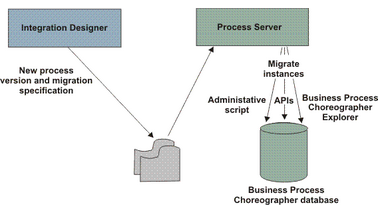You can create a new version of a BPEL process in one of the following ways:
- Create a new version of the BPEL process in Integration Designer, and deploy it to Process Server.
- Update a process in IBM® WebSphere Business Modeler Version 7.0.0.2 or later, export it to Integration Designer, and deploy it to a process server.
- Create a new version of the BPEL process in Integration Designer, deliver it to Process Center, and deploy the corresponding process application or toolkit.
- Create a new snapshot of a process application or a toolkit that contains a BPEL process, which has not been modified, and deploy it.
For example, the following figure shows the steps for defining a new version of the process in Integration Designer through to migrating running instances in Process Server.
To migrate running process instances to a new version of the process, you can use either an administrative script to migrate process instances in bulk, or Business Process Choreographer Explorer to migrate specific instances.When migration is triggered, the process, the variables, and the activities that are at the current position of the process navigation now refer to the new version of the BPEL process and the follow-on navigation depends on the logic of the new version of the BPEL process. The activities that have already been navigated when the process instance is migrated are not migrated. During the migration of a process instance, all the instances of inline human tasks, which belong to this process instance and are not yet in an end state, are also migrated.
If the changes to the process that are contained in the new version of the process do not affect the process logic, such as the display name or description of an activity, a running process instance can be migrated any time during the process navigation. However, if the changes affect the process logic, such as new activities, variables, or conditional expressions are changed, you can migrate a running process instance to a newer version only if all of the changes that affect the logic of the process are after the current position in the process navigation.
For example, any change to an inline human task is considered to affect the logic of the process. You can migrate a running process instance to a newer version only if all of the changed inline human tasks are after the current position in the process navigation.
If events are defined for the BPEL process, you can track process migration using Common Base Events (CBEs). An event can be generated when the migration is started and again when the migration is complete. A history of process migrations is also kept in the Business Process Choreographer database.
Process migration exampleTo work through an example of process instance migration, go to the Business Process Management Samples and Tutorials web site.
- BPEL process model changes and runtime migration
The changes that were made to the process to create the new version determine when and how existing BPEL process instances can be migrated in the runtime environment. Changes to the descriptive or quality-of-service properties are handled differently from changes to the business logic. - BPEL process migration tracking
If events are defined for a BPEL process, you can track process migration using Common Base Events. An event can be generated when the migration is started and again when the migration is complete. In addition, a history of process migrations is kept for each process instance in the Business Process Choreographer database.


 RSS Feed
RSS Feed



